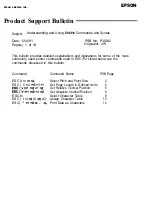
Notes and Restrictions
589
A
ppe
n
d
ix
15
Important •
If [IP Mode] is set to [IPv6 Mode], the IPv6-inIPv4-tunneling cannot be performed.
z
If more than one router exist in the same subnet, a communication error may occur.
z
In a dual stack environment, some services may cause performance problems depending
on the network settings (for example, when you attempt to set the machine to prioritize
IPv6 in an environment where the Web server is started with IPv4).
z
In a multi-prefix environment (where multiple IPv6 global addresses are used), data
transmission from the machine to a device installed on another network may fail.
z
In a multi-prefix environment (where multiple IPv6 global addresses are used), an address
that is not assigned to the machine may be used for communication.
z
The machine may be assigned an unavailable address, such as site local addresses (fec0::)
or the documentation prefix (2001:db8::/32), as an autoconfigured IPv6 address or as an
IPv6 DNS server address.
z
The machine may use the DNS information for IPv4 rather than that for IPv6 if: the
machine is in Dual Stack mode, the DNS information for both IPv4 and IPv6 is configured,
the machine is to be communicate with a device that is specified using the FQDN, and the
machine has just been turned on.
z
The machine may display an incorrect machine address.
Example:
Either the IPv4 or IPv6 address is not displayed in Dual Stack mode.
A different IPv6 address is displayed.
z
When a document is printed via an IPv6 network, the Secure Watermark feature is not
available.
z
A time synchronization server cannot be specified in IPv6 format. Use the IPv4 format to
specify a time synchronization server directly.
z
WINS does not support IPv6 communication.
z
When a self-signed certificate is used for SSL communication, observe the following
restrictions when specifying the printer URL:
- When specifying the machine by using the domain name (for IPv4 or IPv6):
Set the host name and domain name for the machine before creating a self-signed
certificate.
Example:
When the FQDN is "csw.ipv6.domain.local", specify csw for the host name, and
ipv6.domain.local for the domain name.
- When specifying the machine by using the IPv4 address:
Import a self-signed certificate that is created in IPv4 or Dual-Stack mode.
- When specifying the machine by using the IPv6 address:
Secure IPP (IPP-S) communication is not available.
z
When IPv6 is enabled and IPv4 is disabled on the machine, you cannot specify a storage
location for the Browse function of the Scan to PC (SMB) service.
z
When the Scan to PC (FTP) service is used, only ASCII characters can be used for file
names.
z
In the following cases, since the addresses may not be recognized as those of the same
machine, the lpq command (for status check) and the lprm command (for canceling) may
not be available for LPD print jobs.
- When simultaneously operating IPv4 and IPv6 addresses with the same host
- When simultaneously operating multiple IPv6 addresses with the same host
z
IPv6 addresses may not be correctly recorded on job logs. Use an IPv4 network for correct
logging.
Summary of Contents for ApeosPort-V 4020
Page 1: ...Administrator Guide ApeosPort V 4020 DocuPrint M465 AP...
Page 12: ...12...
Page 36: ...1 Before Using the Machine 36 Before Using the Machine 1...
Page 52: ...2 Paper and Other Media 52 Paper and Other Media 2...
Page 68: ...3 Maintenance 68 Maintenance 3...
Page 90: ...4 Machine Status 90 Machine Status 4...
Page 264: ...6 CentreWare Internet Services Settings 264 CentreWare Internet Services Settings 6...
Page 306: ...9 Scanner Environment Settings 306 Scanner Environment Settings 9...
Page 318: ...11 Using the Server Fax Service 318 Using the Server Fax Service 11...
Page 334: ...12 Encryption and Digital Signature Settings 334 Encryption and Digital Signature Settings 12...
Page 610: ...610 Index...
















































